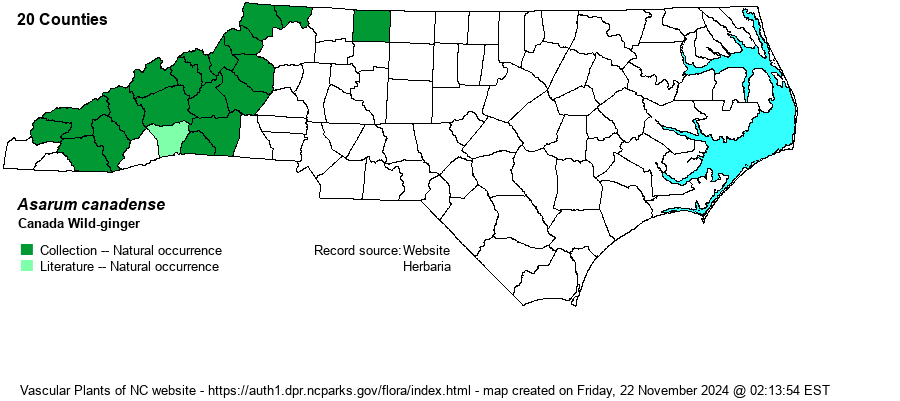| Section 4 » Order Aristolochiales » Family Aristolochiaceae |
Show/Hide Synonym
| taxonName | relationship | relatedTaxonName | relatedTaxonRefText | relComments |
|---|
|
| Asarum canadense | < | Asarum canadense var. canadense | Gleason and Cronquist (1991) | | | Asarum canadense | < | Asarum canadense var. canadense | Gleason (1952) | | | Asarum canadense | > | Asarum canadense var. ambiguum | Fernald (1950) | | | Asarum canadense | > | Asarum canadense var. ambiguum | | | | Asarum canadense | > | Asarum canadense var. canadense | Fernald (1950) | | | Asarum canadense | > | Asarum canadense var. canadense | | | | Asarum canadense | < | Asarum canadense | Flora of North America (1993b, 1997, 2000, 2002a, 2002b, 2003a, 2004b, 2005, 2006a, 2006b, 2006c, 2007a, 2009, 2010) | | | Asarum canadense | < | Asarum canadense | | | | Asarum canadense | < | Asarum canadense | | | | Asarum canadense | < | Asarum canadense | | | | Asarum canadense | < | Asarum canadense | Radford, Ahles, and Bell (1968) | | | Asarum canadense | < | Asarum canadense | | | | Asarum canadense | < | Asarum canadense | Flora of Virginia | | | Asarum canadense | < | Asarum canadense | Wofford (1989) | | | Source: Weakley's Flora |
|
| Author | L. | |
| Distribution | Two other taxa/species in NC have recently been split out from A. canadense. These splits are controversial and not widely accepted, argued by botanists for decades. Weakley (2020), however, accepts the splits, but shows A. canadense as "rare" in the Piedmont, whereas his map for A. reflexum shows that taxon as "common" in the Piedmont. His map shows A. canadense as "common" in the Mountains, but absent in the Coastal Plain. Thus, the website editors have moved all of the SERNEC and USDA records from the Coastal Plain and most of the Piedmont (except for the foothills) of A. canadense to the map for A. reflexum. It is likely that A. canadense occurs farther east than is shown on the map below.
Weakley (2018) list the range for Asarum canadense (strict sense) as "NB and QC west to MN, south to NC and AL". | |
| Abundance | Weakley (2020) says it is "common" in the Mountains, but "rare" in the Piedmont, and absent from the Coastal Plain. However, his map only shows a single abundance code for an entire province, so the species is expected to be more numerous in the Piedmont foothills than farther east. Note that the NHP's state rank of S5 is for the entire A. canadense complex (i.e., before the split was made). In reality, as this species (strict sense) seems to be found mostly in the Mountains in NC, the website editors have changed the rank to [S4?]. | |
| Habitat | This is a species of rich hardwood forests, usually where the soil is circumneutral. It is most often found in Rich Cove Forests, but it can be found in rich floodplain forests and other moist forest types. |
| Phenology | Blooms in April and May, and fruits shortly afterward. | |
| Identification | This is a rhizomatous species that occurs in colonies, with each plant having two leaves close to the ground. They are thin, deciduous, and bright green (as opposed to thick, dark green, and evergreen in Hexastylis species). Each leaf is widely rounded, entire, with a cordate base, about 4 inches wide and long, on petioles also several inches long. The single flower arises where these petioles meet, and lies on the ground, often buried in dead leaves. It is brown to purple, three-sepaled (no petals), producing a triangular-shaped flower from above, being cup-shaped below. In this species, the calyx lobes are over 10 mm (2/5-inch) long, but the tube (cup) is less than 2/5-inch long; the lobes of the calyx are not long acuminate and they are spreading. The very rare (in NC) A. acuminatum has the calyx lobes longer and very long tapering to the tip. The common Piedmont species -- A. reflexum -- has the calyx lobes strongly recurved/reflexed, almost pressed back against the outside of the calyx tube. As long as the flower can be seen and examined, you should not have too much trouble telling one apart from another, but if not present, then likely they cannot be reliably identified. Thankfully, this species and A. reflexum are often encountered in rich forested habitats, so hopefully you can find at least a few plants in the colony in bloom. | |
| Taxonomic Comments | As mentioned above, some authors, but certainly not all, have split out A. reflexum and A. acuminatum from A. canadense (broad sense). However, some do not even name these as varieties or subspecies, including NatureServe; others only as varieties or subspecies. Note that the G5 Global Rank is for A. canadense (broad sense), though it is assumed that A. canadense (strict sense) is also worthy of G5 rank, based on its wide range.
| |
| Other Common Name(s) | Common Wild-ginger, Canadian Snakeroot | |
| State Rank | S5 [S4?] | |
| Global Rank | G5 | |
| State Status | | |
| US Status | | |
| USACE-agcp | UPL link |
| USACE-emp | FACU link |

